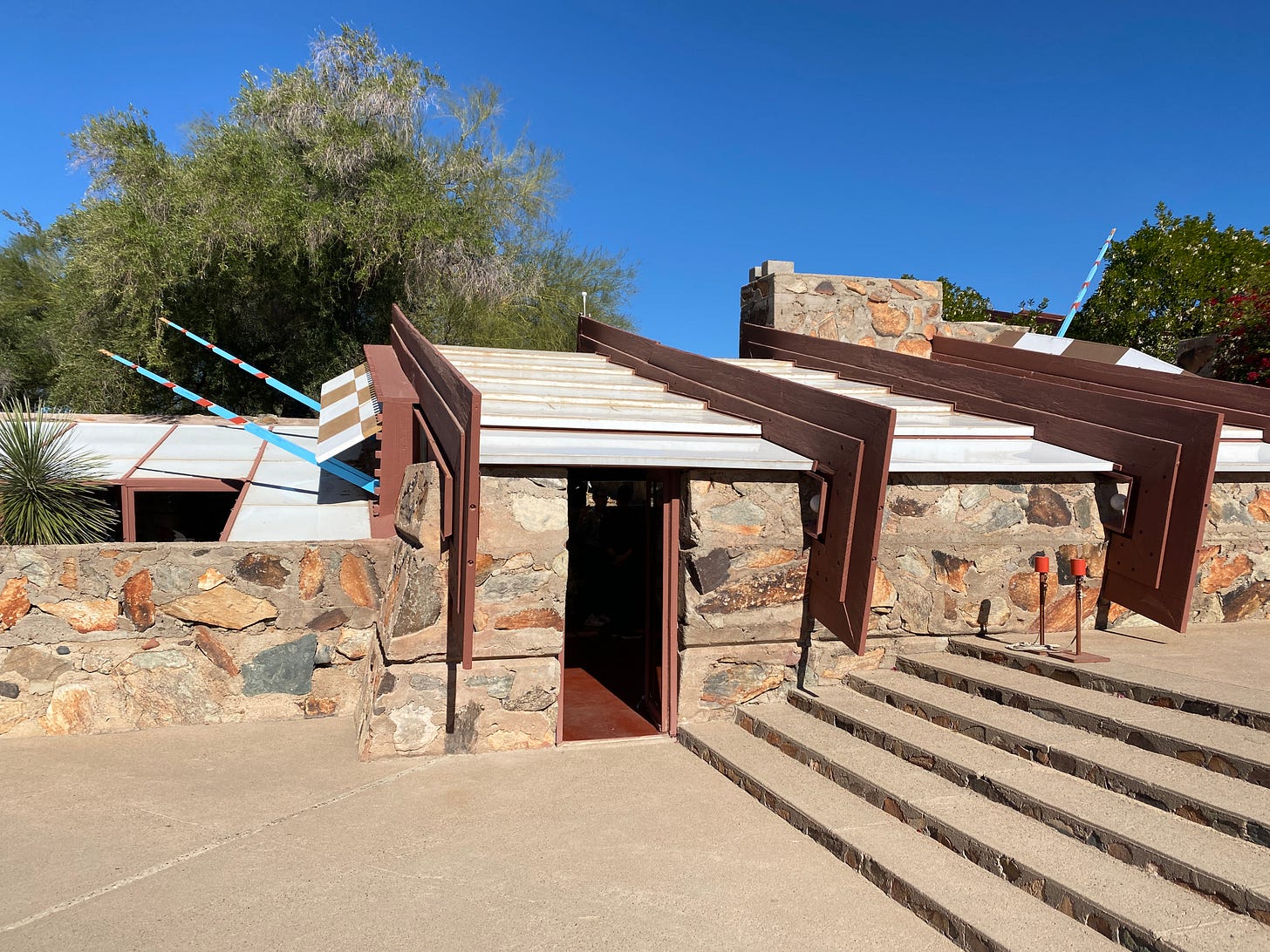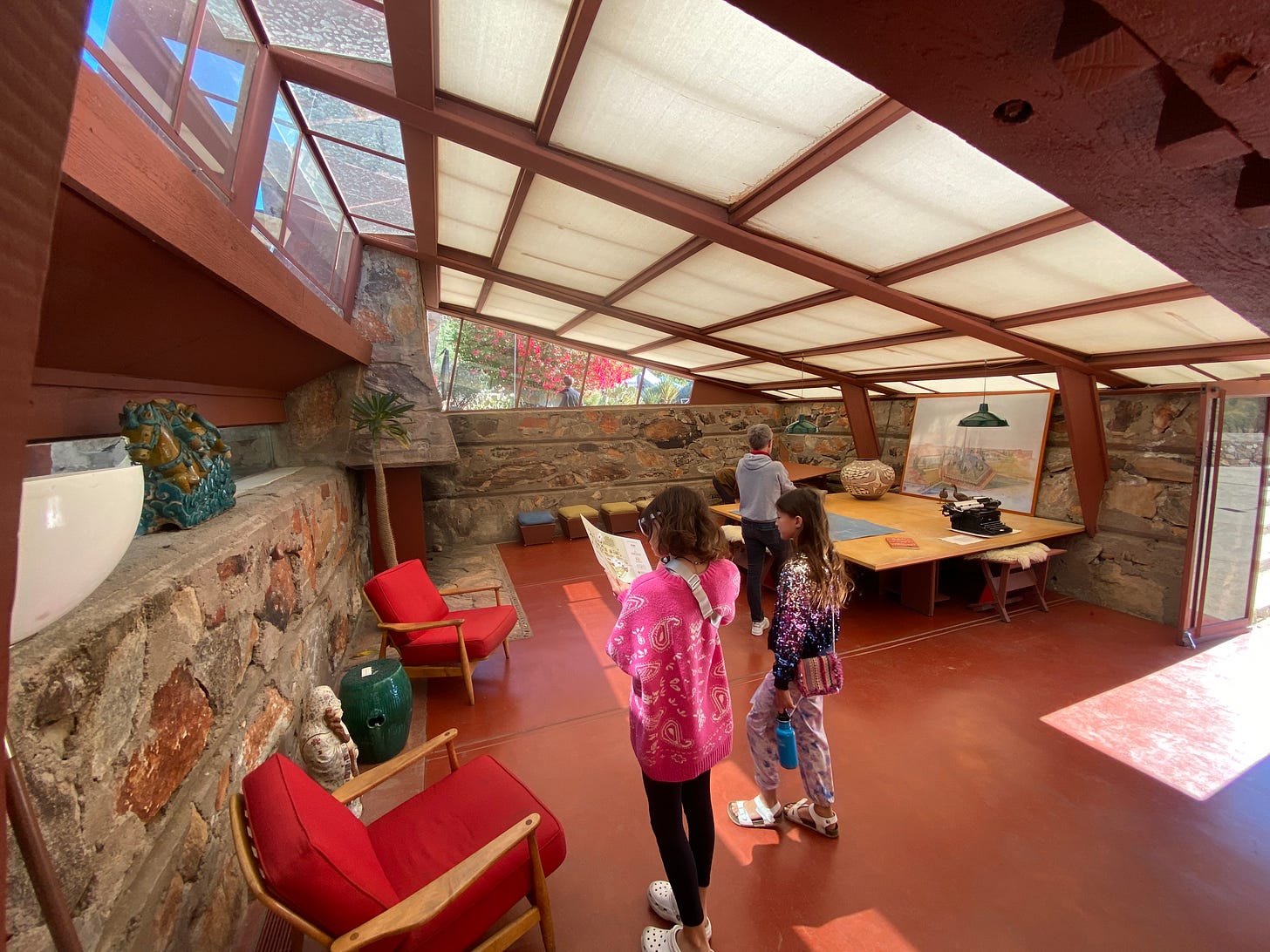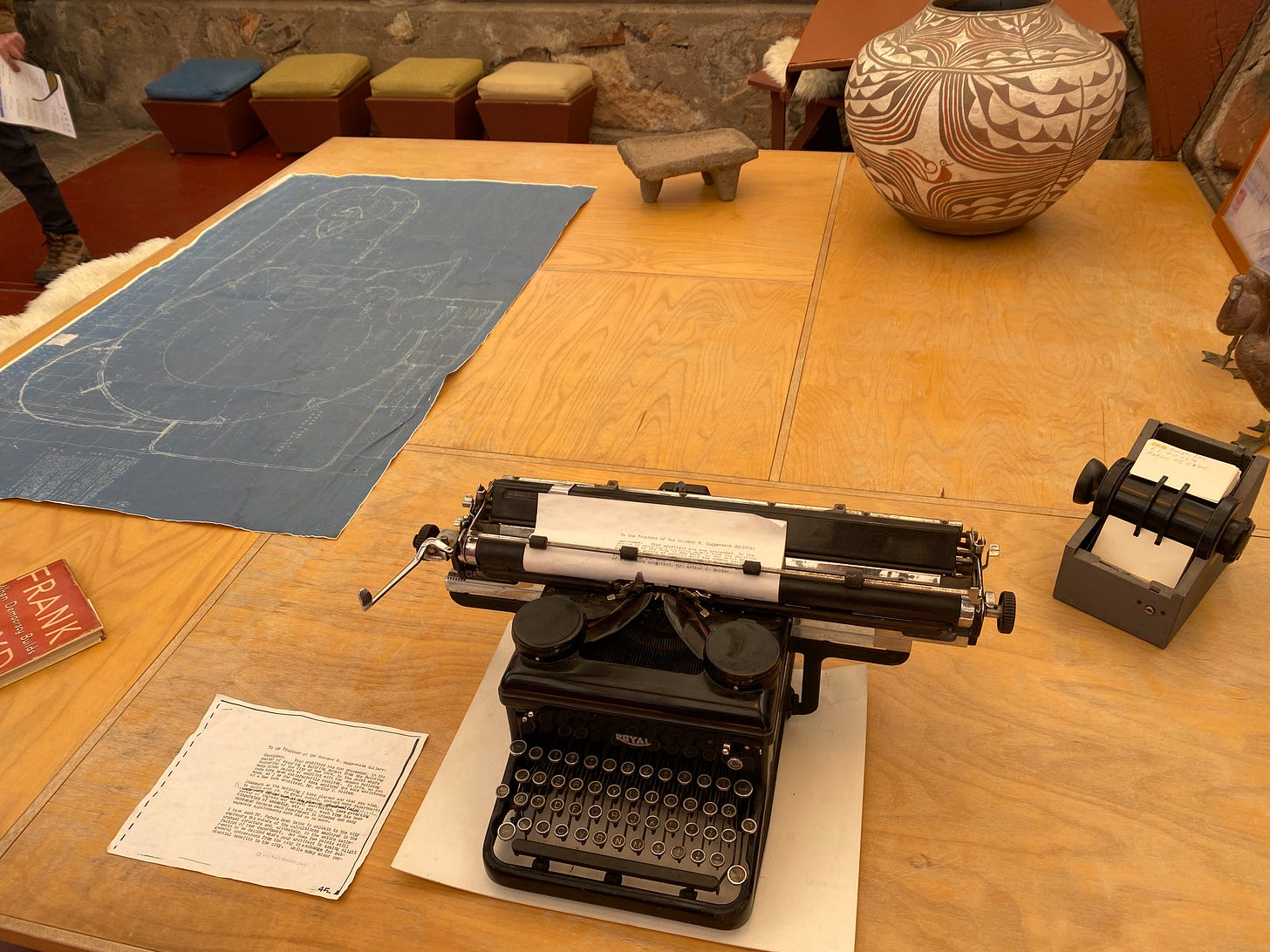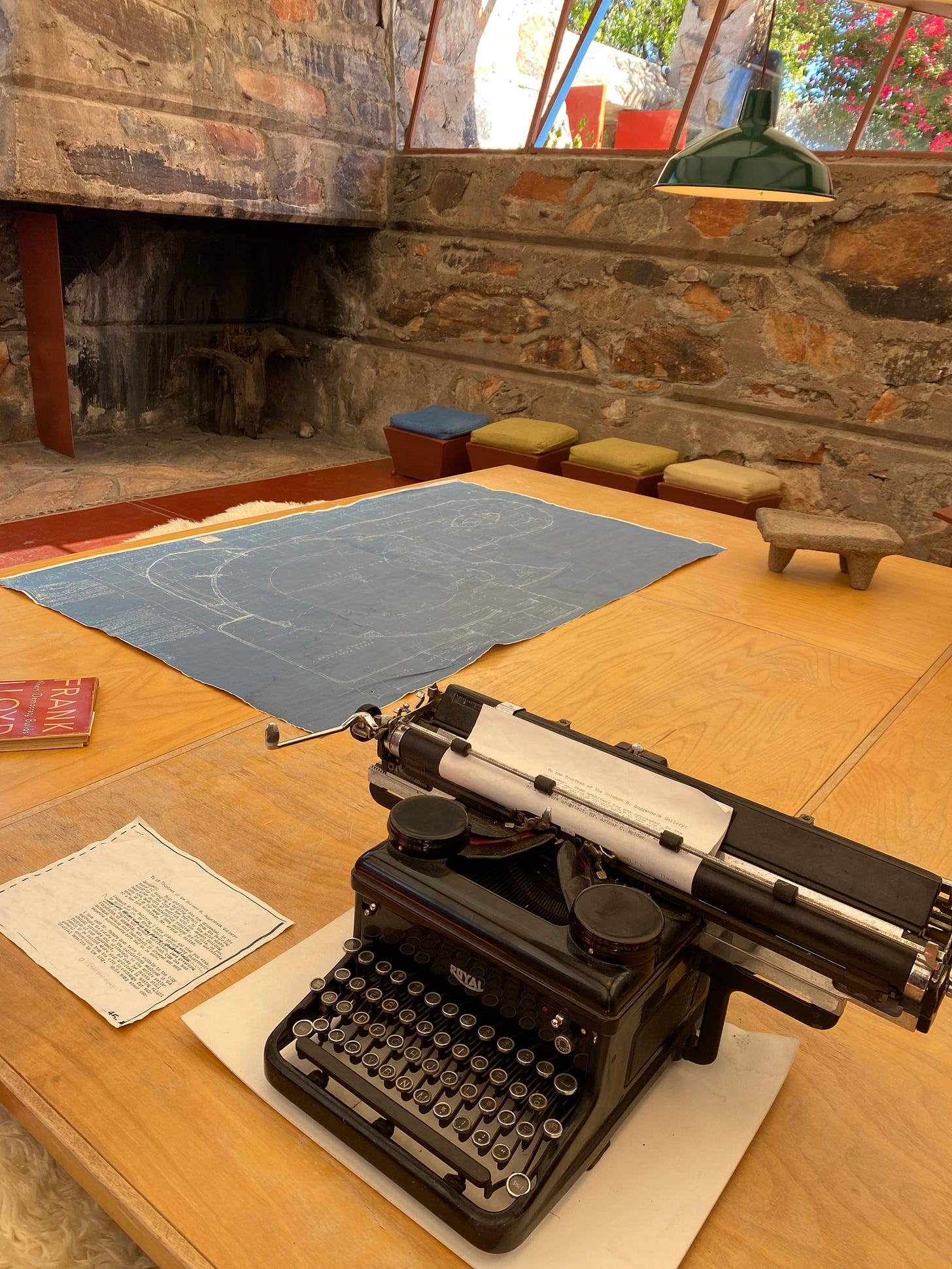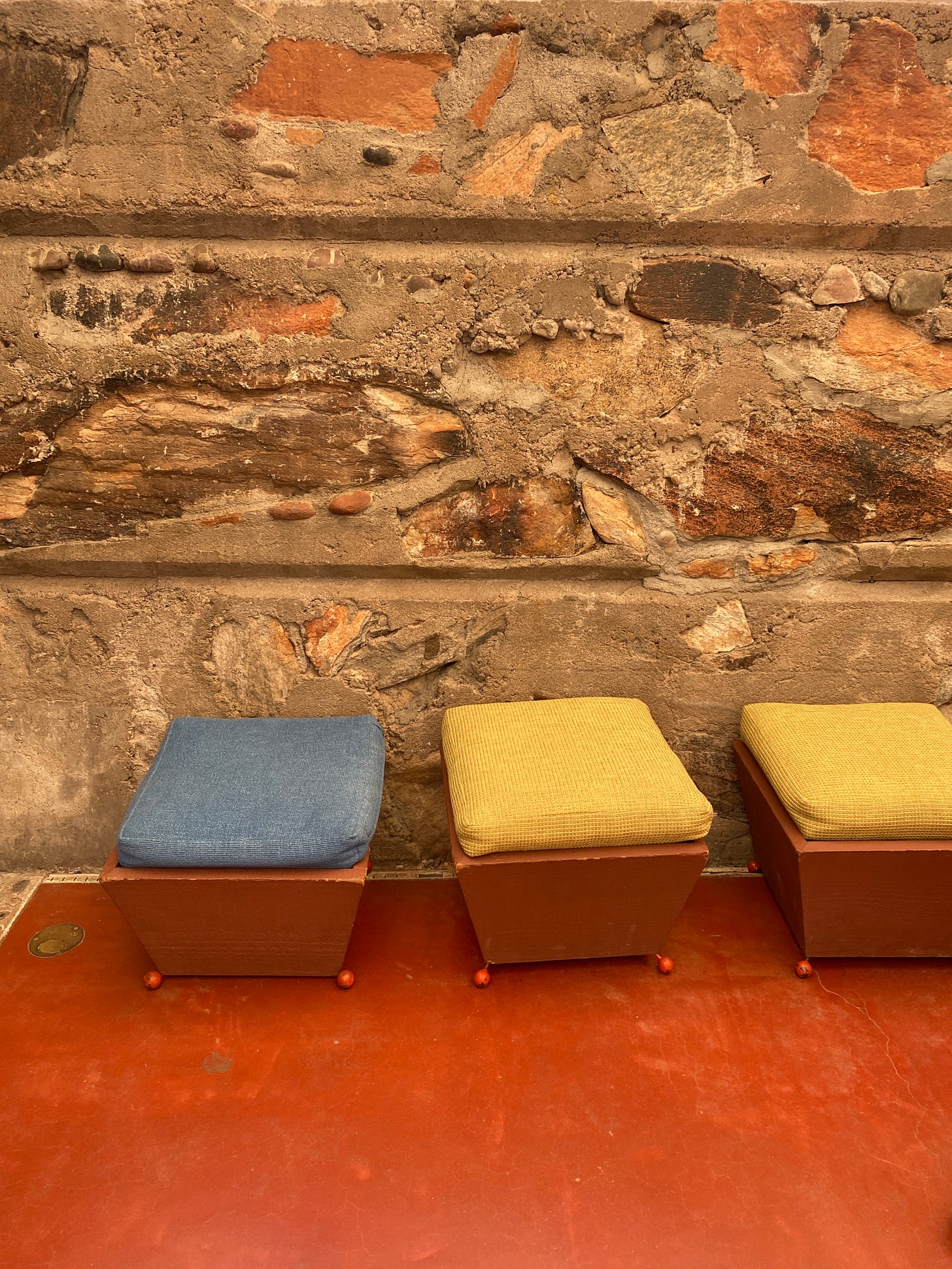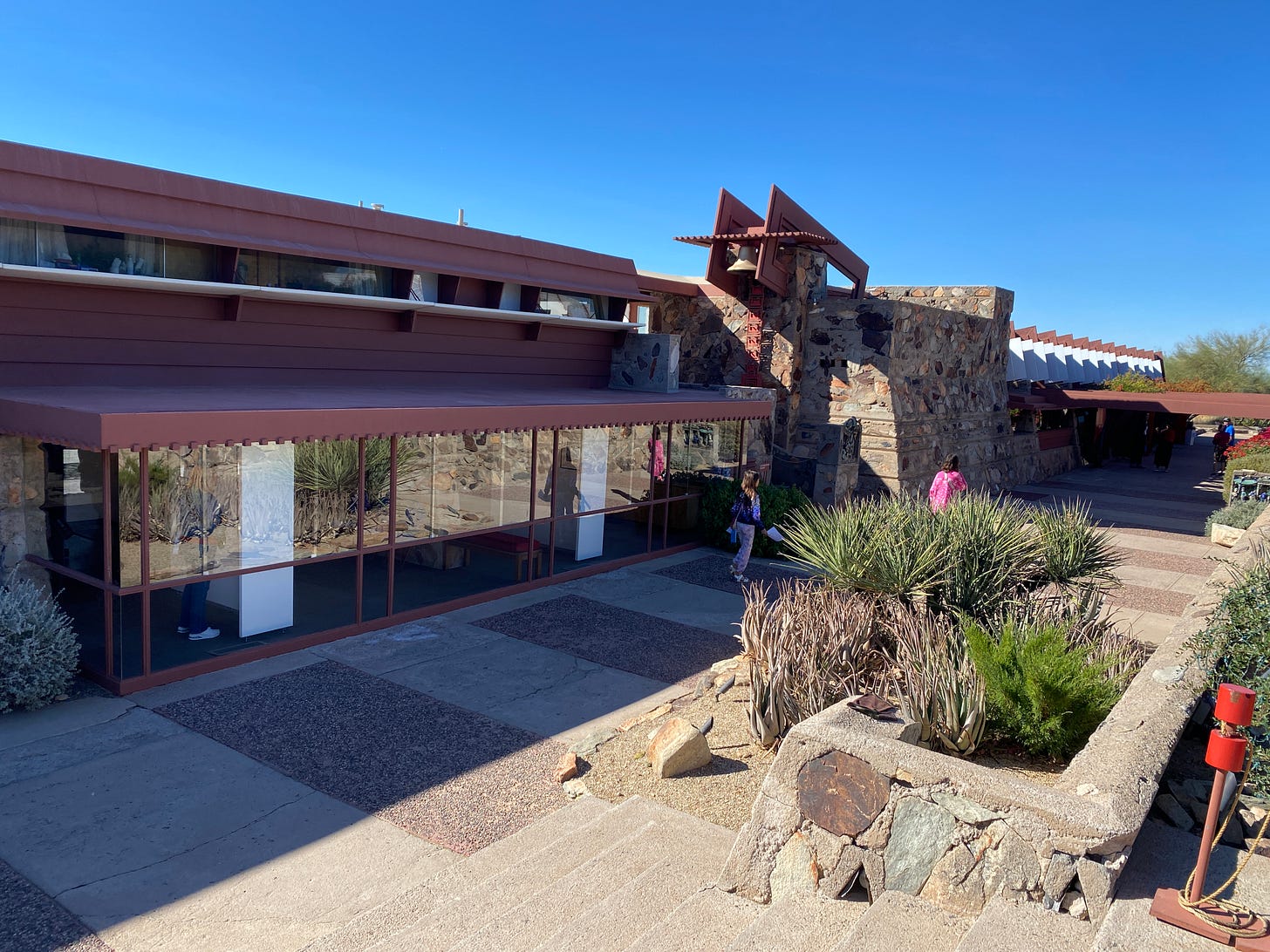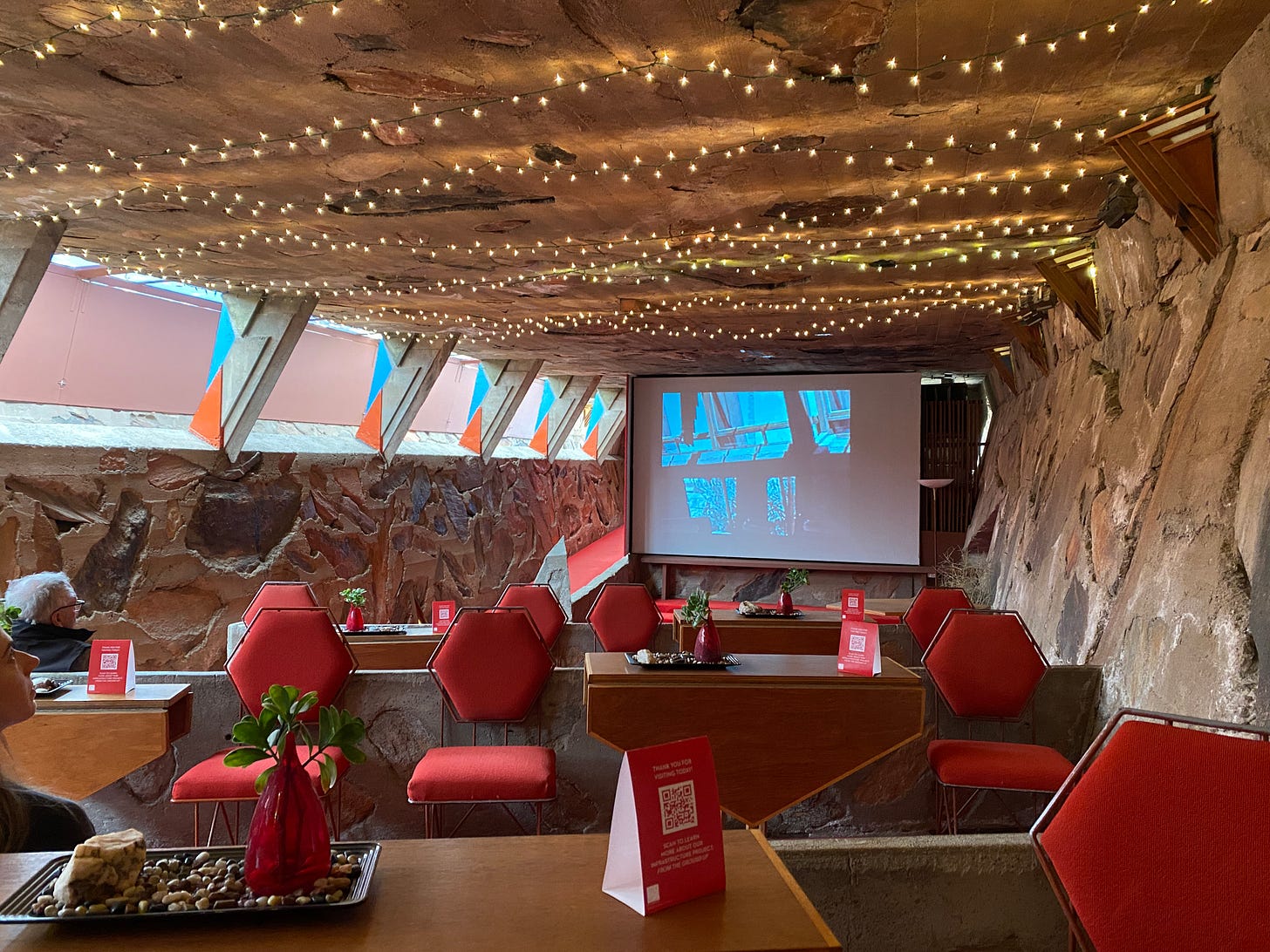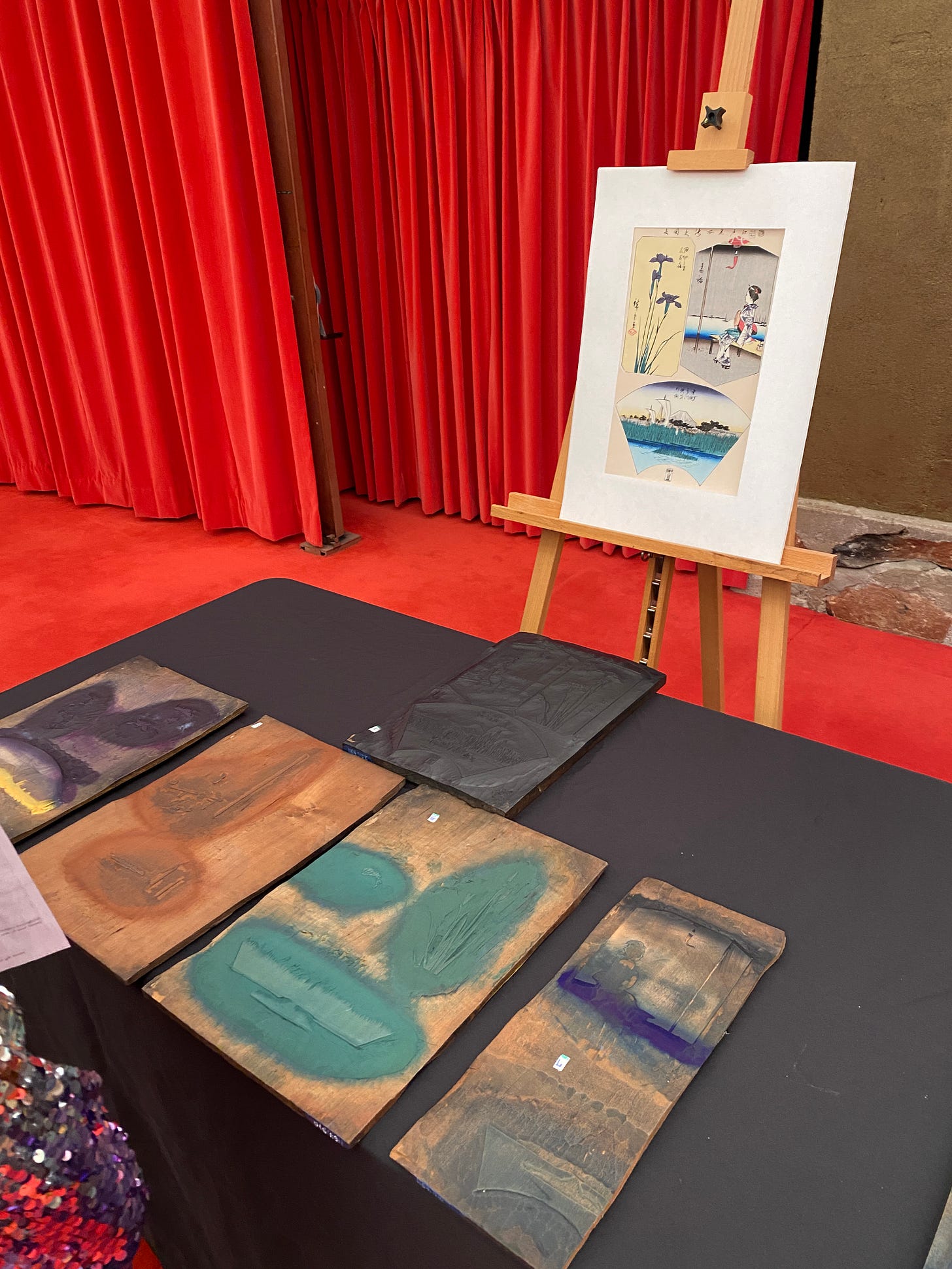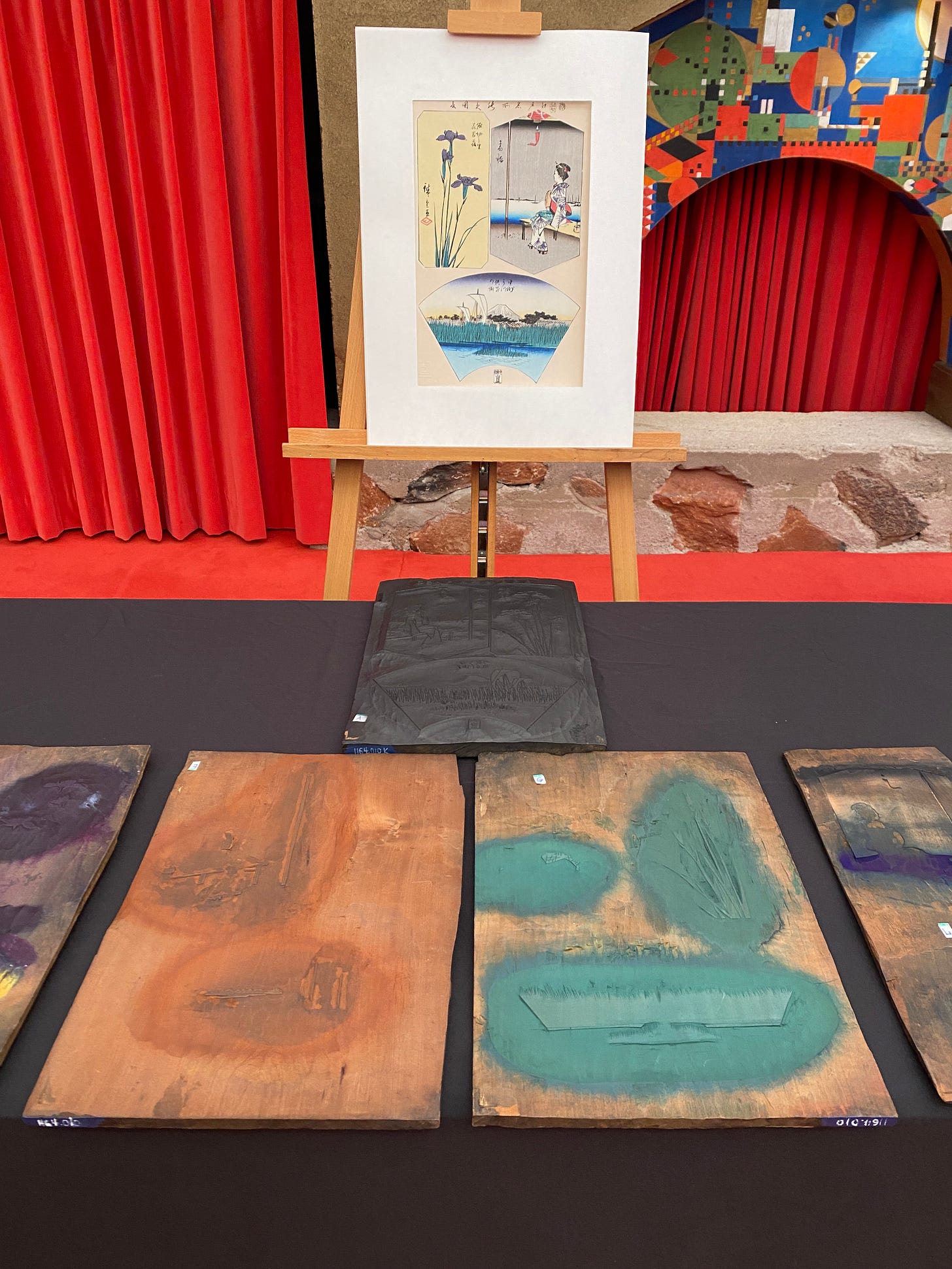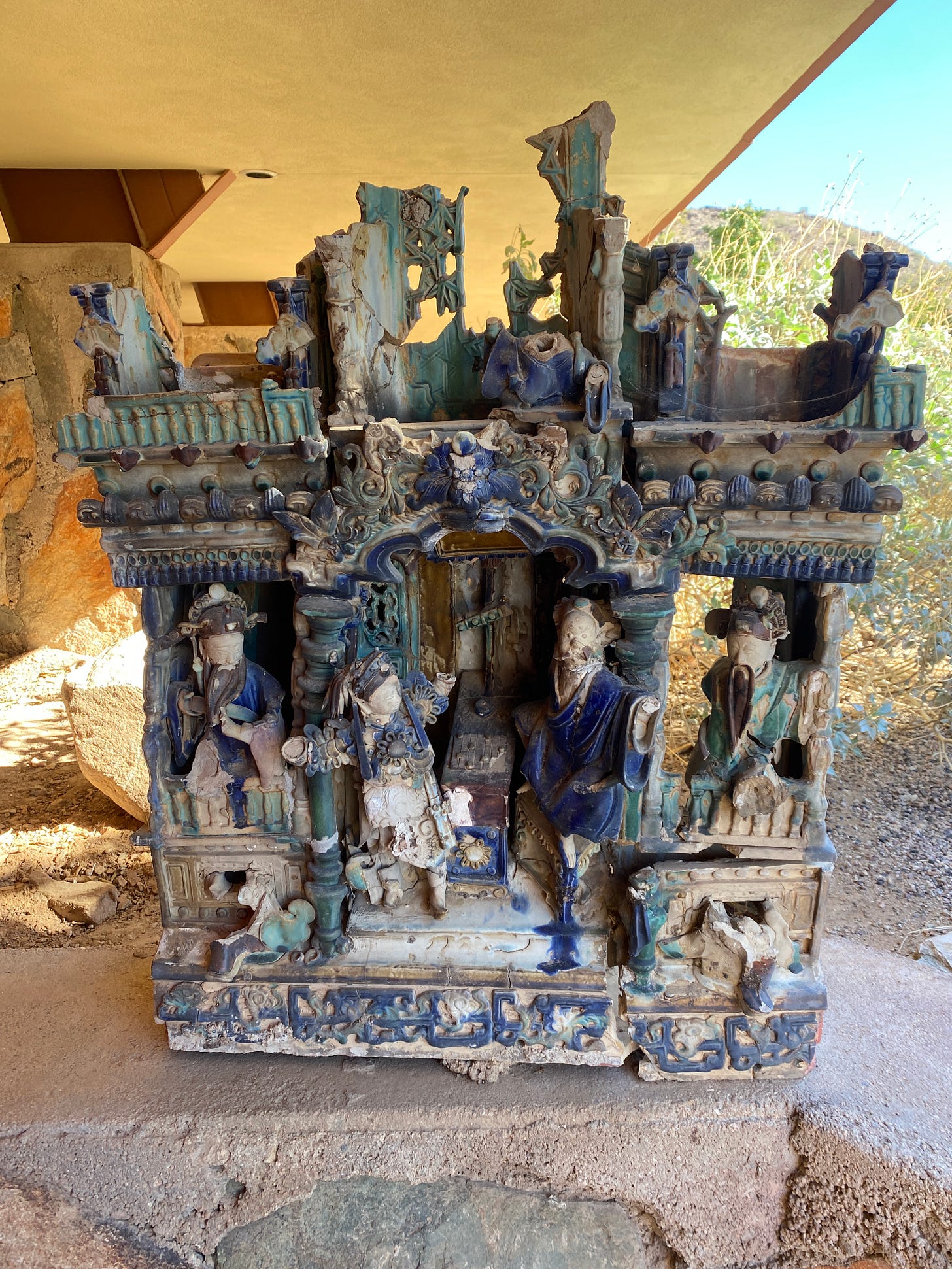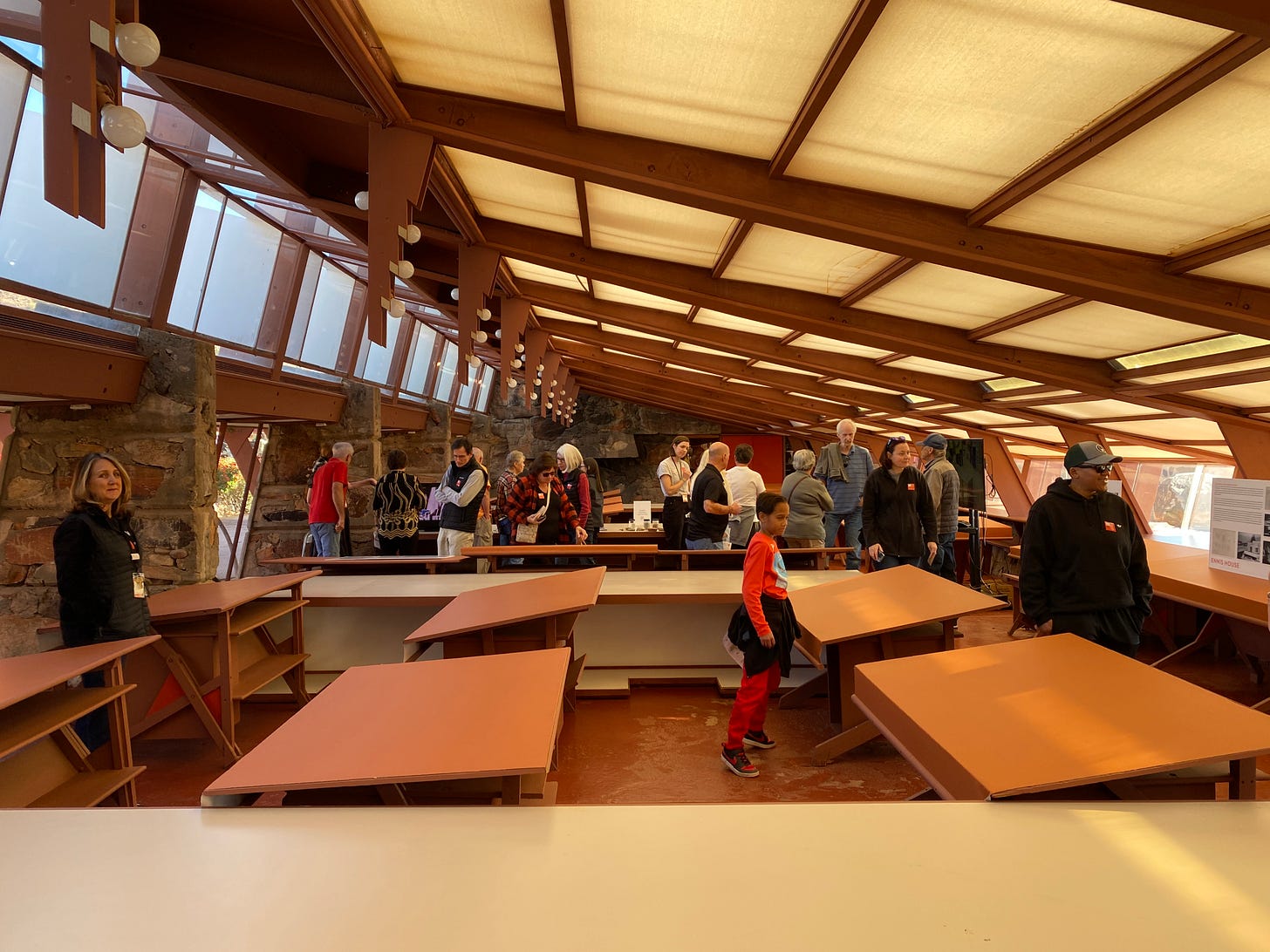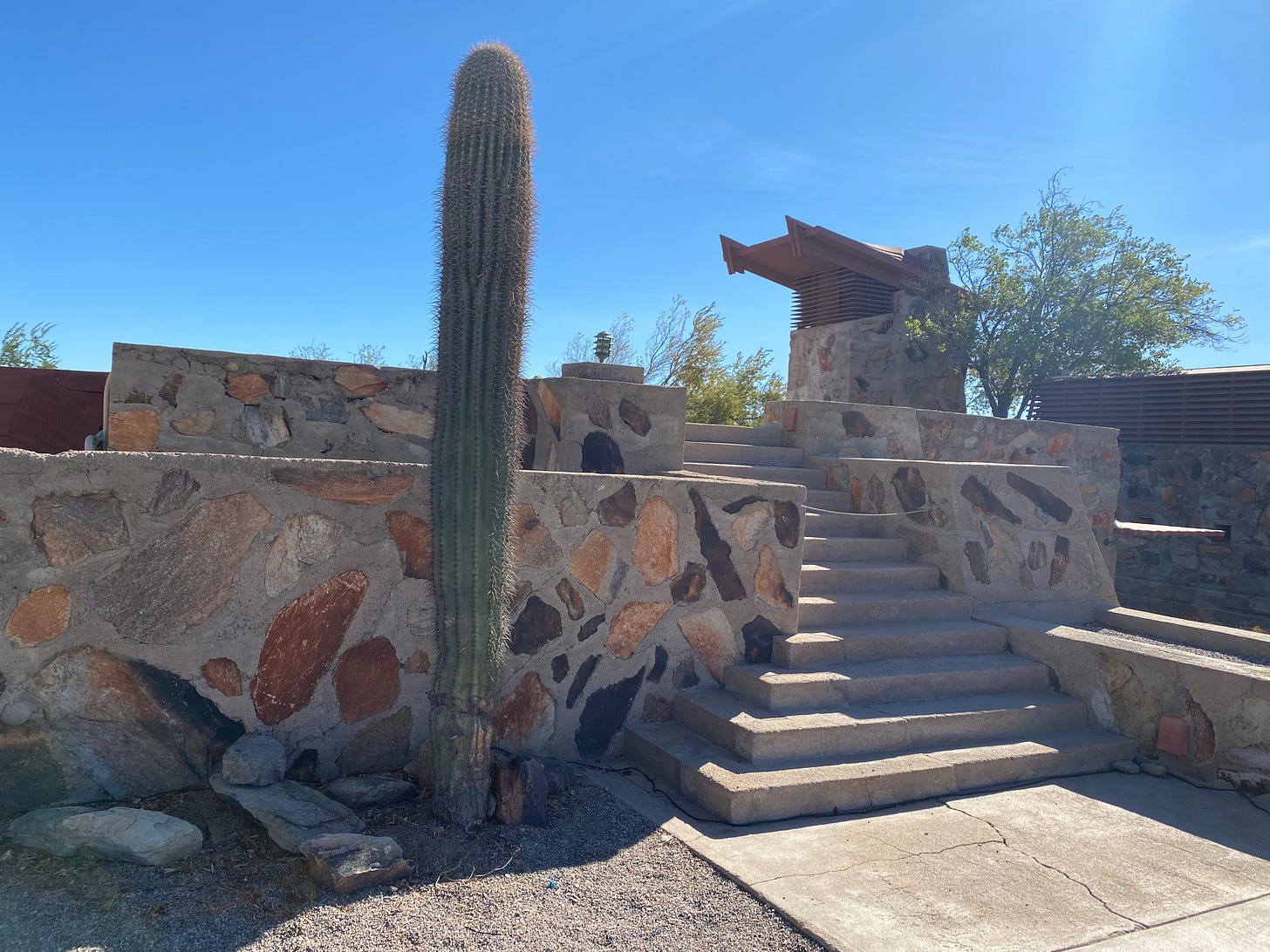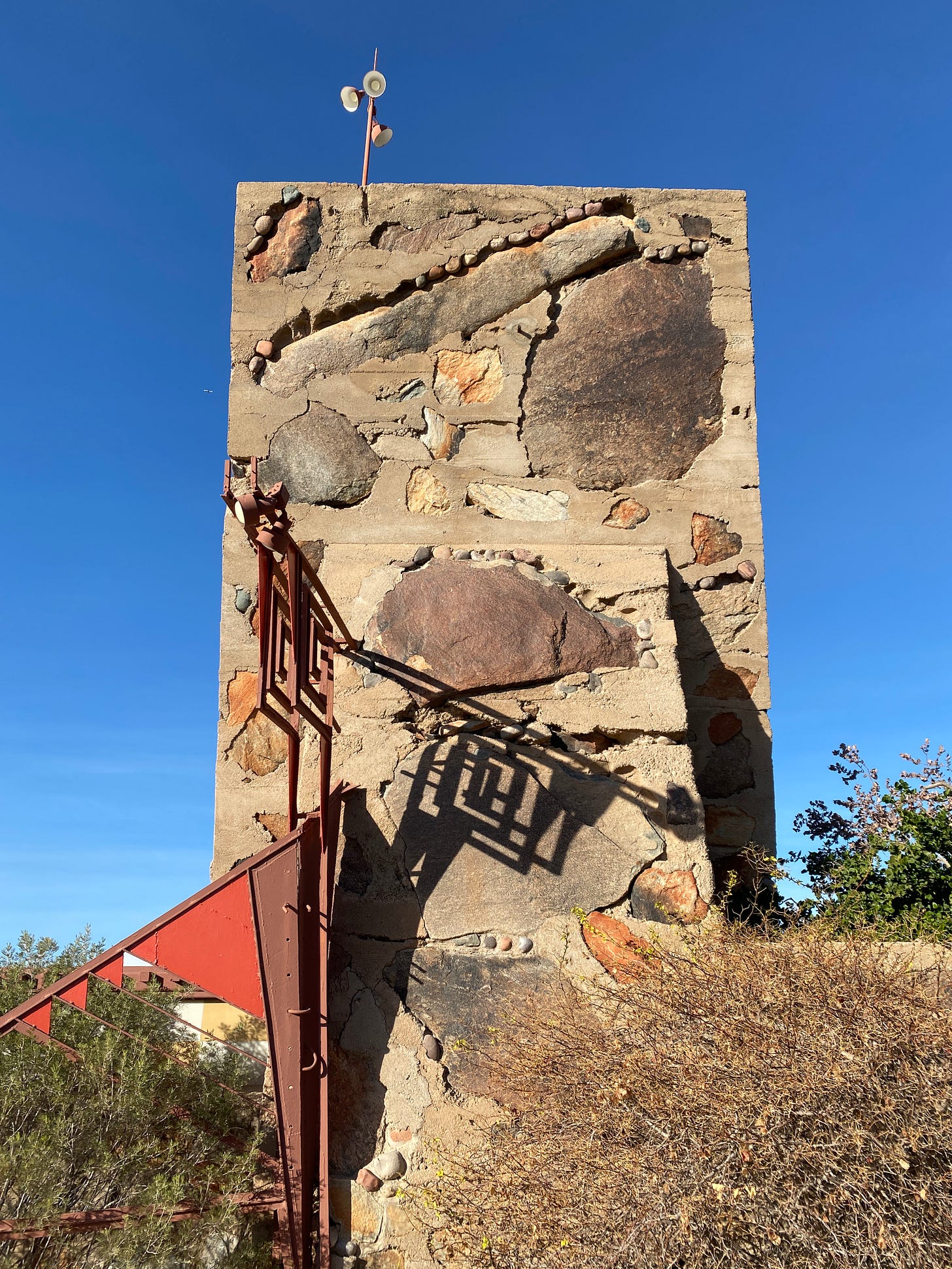Chasing Frank Lloyd Wright's Desert Footprints at Taliesin West
Walking in the outsized shadow and working space of an American giant.
This past weekend, we loaded up in the car and drove five minutes to the site of Frank Lloyd Wright’s iconic home and studio in Scottsdale: Taliesin West.
After living in the area for a couple of years, this was our first visit to the property. Wright’s name is prominently featured throughout the city. He’s the name of one of the main roads and Taliesin West looms large in tour guides and city maps.
Taliesin West doesn’t hit you all at once. You drive up the unassuming winding desert road, that looks just like any other maintenance road you might find in the area. In the near distance, the MacDowell Mountains provide the familiar backdrop of the area. After parking, you walk up to the property and can make out some low buildings on the horizon, but nothing takes your breath away just yet. All you are hit with at first is a blank canvas of desert land on the outskirts of the city. It feels like you’re about to cross a trailhead and go on a hike through the wilderness.
The first place the guides nudge you towards is Wright’s studio. The low profile space seems to rise organically out of the desert floor. A loose but hard-edged construction of sun-scorched desert stone bound by generous quantities of concrete. Slap-dashed concrete becomes the unifying element and organizing principle of the place. Everywhere you look is lined, blocked and triangulated in experimental concrete constructions. Creating a borrowed camouflage that draws the eye to the sharp lines of painted plywood and turquoise accents.
Stepping into Wright’s studio office, everything becomes clear. The abundance of natural light. The feeling of being outside while inside. The desert stones now hang around the space like art pieces inset in the walls. The space is minimal, but filled with eccentric and specific details at every turn. Choices were made here. Choices that defined this literal space, and grander choices that slipped through the studio doors and open windows and soared across the desert air. Ideas that materialized into era defining structures like the Guggenheim. Ideas that all started as reductionist lines and abstracted shapes drafted by Wright’s hand in this room.
Everything in the space had a handmade quality to it. Nothing was perfectly straight. Walls seemed to jut out at unexpected angles. Nothing was symmetrical. It kept my eye wandering and looking out for the next little point of interest. I imagined Wright sitting in this room, staring at the stones in the wall or out at the desert beyond the windows, and letting his mind wander through an endless rolodex of shapes, structures and possibilities.
It also made me think about how interesting a simple wall could be. We’ve moved far from any kind of ornamentalism in our minimalist and efficient future. But these structures treated even the walls as art. The way the stones were placed. The imperfect texture of the concrete. There was human intention and emotion behind it all. Again, everywhere, choices were made. A robot or AI could never create walls like this. There is no logic behind it. It shows evidence of a very human process. Going into the desert, using what was around and arranging it in a structurally sound and artful way. The results hold up. They feel personal and lived in.
These structures exist out of sheer human will and imagination. I still feel that humans will always be drawn to appreciating craft and the evidence of a creative process. We like to see what other humans are capable of. There’s no emotion behind perfectly 3D printed walls and structures. Those solve a different problem. Here, at Taliesin West, the mandate was to conjure from the earth, a space able to inspire humans to dream even deeper dreams. Do robots dream of electric sheep? Do robots even dream at all?
The direct sunlight of Scottsdale’s afternoon, coupled with the crisp blue sky, brought contrast and pop in every direction. As we walked the campus, the points of interest kept stretching out before us. Greeted with unusual choices at every turn. Another autobiography in wood and stone. Now the campus has the energy of a set of museums, with people like us taking in the environment as history and fine art. But I tried to imagine Taliensin West at its working prime. Buzzing with activity and ideas. Jobs to be planned and executed. A factory of factory builders. An engine that needed to break down barriers and walls to imagine space differently. Minds ablaze with sorting out how to turn thin air into indelible magic.
Pathways and secret tunnels stretched out before us. Giving the sensation of walking into the combination of a cave mixed with a magic eye painting. We lost ourselves in the illusions. Entering one portal, only to come out in a movie theater or a music hall. Spaces were woven through the grounds to import inspiration and culture. The buildings blurred the lines between business and pleasure. With each step we fell deeper down the rabbit hole of possibilities. Everyone caught in the trance, from children to adults were left with the same feeling. What would it be like to live and work in a place like this? Imagine the possibilities to be lucky enough to call this your home base. I’m sure even just a passing tour must change your reality in some way. Let alone the radical transformation that must occur returning day after day.
We sat in the cave like theater and watched as silent footage played, showing Wright and his apprentices trekking through the Arizona wilderness. Taking in the epic sights of nature’s splendor—gargantuan stone sculptures, saguaro cactuses twisted with individuality and intrigue and the repeating patterns of a desert drive. Time stretching out into a repeatable rhythm. Row of triangles here. Strand of circles there. Lines bisecting the sky. This is how the human algorithm gets trained. Pay attention to things deeply and it changes how you see. New possibilities emerge out of the old and taken for granted. Triangles. Lines. Dots. Resulting in buildings that look like nature. And nature that becomes fresh paint on the architect’s pallet. As the silent images stretched on, we could relate. The views are free to all. But not all that look on a desert drive see the same thing. Some see layers beyond the literal. And then some do something with that spark.
Little whispers of Wright’s interest in the far east echoed throughout the space. From battered and sun beaten eastern ceramic sculptures to Buddha heads to a theater displaying some of his Japanese woodblock prints. The point of interest here was that Wright not only collected the prints as any tourist could, but he also sought out the original woodblocks behind the prints. This showed his forever interest in the process of human creation. Displayed together, the art turned into something else. It was a case study in human intention. It was evidence of human ingenuity leveraging nature and bending it to its will to tell a story and leave a physical record behind. The results are not to be taken at face value. The value is in the process and intention to create.
We stood there looking at these immaculately crafted, rough slabs of wood. Wood taken from the earth, that could have ended up as a wall or a plate or a door on a building. We noticed the combination of the rough, raw wood, and the human precision overlapped upon it, with exact corners to ensure that the ink would fall perfectly in sync with the other layers of the artwork. What can we find or scavenge that we impose such precision of thought onto? The creative riddle lingers.
Even behind the scenes, hidden from the final art, art exists. Outside the theater, we were invited to make our own ink block prints. There, side by side, all ages rolled pigment and pressed designs onto paper with wooden spoons. Given a generous moment of creation. To participate and express in the inspiring environment. It was a simple reminder of how elemental and essential it feels to create something. Anything. To use your hands. Get them smudged with ink and just make.
East meets west throughout the grounds of Taliesin West. The collision of opposing forces used to create new combinations. The event organizers even brought in a Japanese taiko drum group to add another layer to the atmosphere. Sending a structure of rhythms and beats throughout the space that enhanced the immersive experience.
The main building featured the most wide open space, which would have been where the army of draftsmen and draftswomen stood, hunched over art boards, designing future structures. Today, the space is used to host classes and workshops, carrying on the philosophy and traditions of time passed. As with everywhere on the campus, the interiors and exteriors blend, with wide open windows and an abundance of natural light. A little gallery display showed the down to earth, rudimentary way the buildings were constructed. Virtually all built by apprentices. Making plywood frames, adding local rocks from the nearby desert and finally pouring in the concrete. It worked this way with benches, walls and any other structure on the site.
The hand of man was intentionally hidden, like in the below picture, which shows a wall—behind which lie an army of air conditioning units. As you walk around the space, what you don’t see informs your experience just as much as what you do.
Everywhere was a celebration of the unnecessary. Walls jut beyond logical bounds, infringing on the sky above. Extra little flourishes protrude from corners. Surfaces remain unfinished, experimental. None of these little touches could be logically explained to some board or committee. Yet they become the signature and fingerprint of the architecture. The buildings tend toward minimalism in their form and function, but the surface is littered with personality. Bold choices that provoke a response.
The whole day was a tour of light and shadow. Of rock and sand. Stepping stones and vanishing footprints. The distant past lives on and echoes thoughts of what the future should hold and what it could be, again. We’ve passed this moment of extravagance and spectacle. We are in a conservative place now, filled with logic and risk-aversion. Frank Lloyd Wright was a gargantuan character. He created a shadow on the American psyche as big as the buildings he’s known for. For better and for worse, he was a character. And that character is evident in the walls and halls of Taliesin West.
Andrew “Oyl” Miller is an advertising Creative Director and Copywriter. He spent 15 years working at Wieden+Kennedy on brands like Nike, PlayStation and IKEA. You can check out his work on his website.





